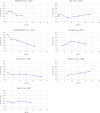The prevalence of atopic dermatitis beyond childhood: A systematic review and meta-analysis of longitudinal studies
- PMID: 28960336
- PMCID: PMC5830308
- DOI: 10.1111/all.13320
The prevalence of atopic dermatitis beyond childhood: A systematic review and meta-analysis of longitudinal studies
Abstract
Background: There are sparse and conflicting data regarding the long-term clinical course of atopic dermatitis (AD). Although often described as a childhood disease, newer population-based estimates suggest the prevalence of pediatric and adult disease may be similar.
Methods: Our objective was to determine whether there is a decline in the prevalence of AD in population-based cohorts of patients followed longitudinally beyond childhood. We conducted a systematic review and meta-analysis including studies assessing AD prevalence across 3 or more points in time. The primary outcome was weighted overall risk difference (percentage decrease in AD prevalence).
Results: Of 2080 references reviewed, 7 studies with 13 515 participants were included. Participants were assessed at 3-6 time points, ranging from age 3 months to 26 years. The percentage decrease in prevalence after age 12 was 1%, which was not significantly different from zero (95% confidence interval -2%-5%). Similar results were found with other age cut-offs.
Conclusion: The prevalence of AD in longitudinal birth cohort studies is similar in childhood and adolescence/early adulthood.
Keywords: atopic dermatitis; atopic eczema; eczema; natural history; prevalence.
© 2017 The Authors. Allergy Published by John Wiley & Sons Ltd.
Figures



References
-
- Johansson SG, Bieber T, Dahl R, et al. Revised nomenclature for allergy for global use: report of the Nomenclature Review Committee of the World Allergy Organization, October 2003. J Allergy Clin Immunol. 2004;113:832‐836. - PubMed
-
- Weidinger S, Novak N. Atopic dermatitis. Lancet. 2016;387:1109‐1122. - PubMed
-
- Williams HC. Clinical practice atopic dermatitis. N Engl J Med. 2005;352:2314‐2324. - PubMed
-
- Bieber T, Bussmann C. Atopic dermatitis; Chapter 12 In: Bolongia JL, Jorizzo JL, Schaffer JV, eds. Dermatology. 3rd ed 225:97‐192: Elsevier Saunders; 2012.
Publication types
MeSH terms
Grants and funding
LinkOut - more resources
Full Text Sources
Other Literature Sources

